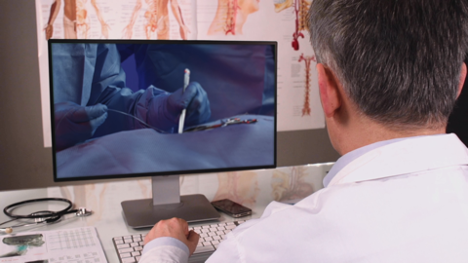With Physician Deficit Forecast, Medical Field to Turn to National Bioskills Labs, CrowdOptic Partnership

By 2032, the United States is predicted to see a shortage of nearly 122,000 physicians, according to the AAMC (Association of American Medical Colleges). In the continuing nightmare that is the global coronavirus pandemic, how can this be, as it seems now more than ever healthcare (public or private) is arguably the most “essential” industry out there?
COVID-19 aside, our nation’s health crisis still falls back to reducing obesity and tobacco use, simple fixes via dietary adjustments and self-control. But AAMC’s President and CEO, Darrell G. Kirch, MD, believes that as the nation’s population continues to grow and age, we will continue to need more doctors if we are to reach population health goals such as reducing obesity and tobacco use. “Even with new ways of delivering care, America’s doctor shortage continues to remain real and significant,” Kirch shared in a recent AAMC press release.
With the nation’s population estimated to grow by more than 10% by 2032, the aging population will be the driving force behind the change in physician supply, since one-third of all currently active doctors will be older than 65 in the next decade. And when these physicians decide to retire could have the greatest impact on supply. But this begs the question of our nation wanting our physicians to have the most updated and sophisticated technology so that patients like you and me are never really out of reach for medical care. Just think back to when COVID-19 first struck and businesses began shutting down, specifically physician offices and dental offices (until they figured out how to address the immediate demand of patient care).
Yet why is it that we are beginning to see the true “entrepreneurial spirit” from the medical industry now simply because the global pandemic, with over 4 million confirmed cases in the United States, has claimed the lives of over 145,000 Americans? That’s what Douglas Hampers, MD, and National Bioskills Laboratories (NBL) have been working to change. NBL, a leading provider of surgical training facilities, unveiled its medical-grade remote physician training platform back in May in response to the travel restrictions COVID-19 placed upon surgeons who traveled for educational purposes or patient consultations.
The company’s newest platform, National Bioskills Live Connect™, combines high-resolution video live streaming from medical devices with real-time, collaborative audio-conferencing capabilities specifically designed for physician skills-training. Capable of streaming multiple video outputs from surgical cameras and medical equipment (such as C-arms or ultrasound machines) simultaneously, the platform uses cloud-based software and proprietary hardware with Intel components from CrowdOptic.
The brainchild of serial entrepreneur and visionary Jon Fisher, CrowdOptic is an enterprise software company that uses a scalable platform to deliver intelligent camera control and video analytics in real time. Fisher, the visionary behind Bharosa, a leading provider of fraud prevention and authentication-security solutions that was acquired by Oracle for a reported $50 million in 2007, amongst others including NetClerk, a technology company that offered contractors a way to apply for permits online and is now part of Roper Technologies.
Where CrowdOptic’s technology comes into play with NBL’s system, starts with the first patented solution it created for wearable technologies, such as Google Glass. “With its partnership with CrowdOptic, NBL can now reach a nearly unlimited number of physicians, healthcare workers, and sales teams,” Fisher shared with us. “NBL now has the ability, thanks to Live Connect™, to take this technology and empower anyone to create their own teaching environment anywhere in the world. Now ORs, surgical centers, and home offices can set up their own teaching studios for an unlimited number of people to learn and interact remotely. The more we can improve this type of education, the better the patient outcomes will be for all.”
And what does Hampers and NBL have to say about the partnership? “We can’t accept lag times, fuzzy images, or unsecured technology,” Hampers added. “So we designed a medical-grade system to be 100% reliable with razor sharp images and real-time audio, and top-tier security that is HIPAA compliant.”
NBL was founded by board-certified physicians and educators to help improve patient outcomes by using CrowdOptic’s state-of-the-art facilities to help train doctors on proper techniques when working with new medical implants.
But as we turn back to the state of our economy today, we look to both technology and legislation. To help address the physician shortage, the bipartisan Resident Physician Shortage Reduction Act of 2019 ( S. 348, H.R. 1763) has been introduced in Congress to provide increased Medicare support for an additional 3,000 new residency positions each year over the next five years. “The data consistently show a significant physician shortage. Because it takes seven to 15 years to train a doctor, we urge Congress to remove the freeze on federal funding for residency training that has been in place for over two decades without delay.”
As for the future of CrowdOptic and NBL’s technological partnership, think of this as a “plug and play” for remote physician care. The technology features low latency video/audio live streaming (less than 0.2 seconds), the ability to simulcast streams from any medical equipment with video output, as well as from the included 4K pan-tilt-zoom cameras that can be controlled remotely. It also offers user-friendly options like webcam sharing, screen sharing, annotation, and dial-in phone conferencing. Host companies can stream from as many devices as they need and can hold simultaneous events from different locations.
COVID-19 has sparked a revolutionary change in the way that medical attention is provided in 2020, now providing physicians with the tools to “always be available” and for consumers to never be deprived of medical care. This is how augmented reality should be used and this is the way in which we can see its mass adoption.



























